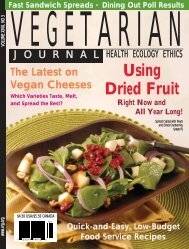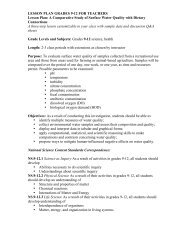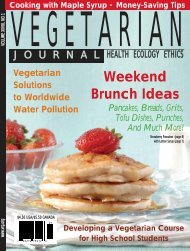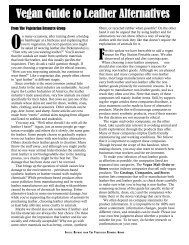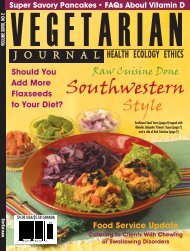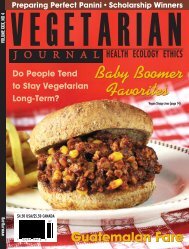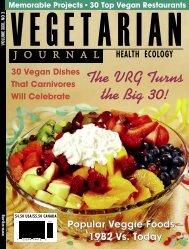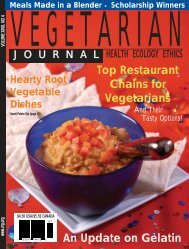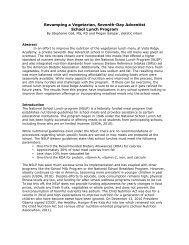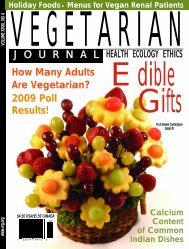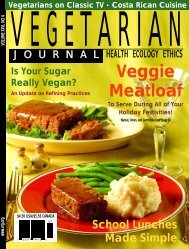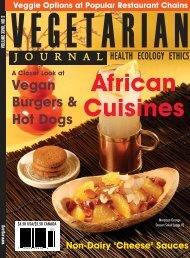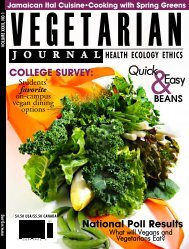Vegan Thickeners - The Vegetarian Resource Group
Vegan Thickeners - The Vegetarian Resource Group
Vegan Thickeners - The Vegetarian Resource Group
You also want an ePaper? Increase the reach of your titles
YUMPU automatically turns print PDFs into web optimized ePapers that Google loves.
grains daily. So keep brushing and flossing and be sure<br />
to eat plenty of whole grains, including whole wheat<br />
breads, whole grain cereals and pasta, and brown rice.<br />
Merchant AT, Pitiphat W, Franz M, Joshipura KJ. 2006.<br />
Whole-grain and fiber intakes and periodontitis<br />
risk in men. Am J Clin Nutr 83:1395-1400.<br />
<strong>Vegetarian</strong>s Have Lower Levels<br />
of Dioxins and Furans<br />
Dioxins and furans are among the most toxic substances<br />
known. <strong>The</strong>y increase risk of cancer and other health<br />
problems. A major source of these toxic substances is<br />
waste-burning incinerators that release dioxins and<br />
furans into the atmosphere. <strong>The</strong>y then accumulate in<br />
foods, especially in animal fats and fish. <strong>Vegetarian</strong>s<br />
who do not eat animal fats or fish would be expected<br />
to have lower blood levels of dioxins and furans. A study<br />
of adults in Taiwan who lived near municipal waste<br />
incinerators for at least five years compared blood levels<br />
of dioxins and furans in 33 vegetarians and 1,675 nonvegetarians.<br />
<strong>Vegetarian</strong>s had significantly lower levels<br />
of dioxins and furans. Results of this study are similar<br />
to other reports that found that fish, seafood, dairy<br />
products, pork, poultry, and beef were all significant<br />
sources of dioxins and furans.<br />
Chen H-L, Su H-J, Lee C-C. 2006. Patterns of serum<br />
PCDD/Fs affected by vegetarian regime and consumption<br />
of local food for residents living near<br />
municipal waste incinerators from Taiwan. Env<br />
Intern 32:650-55.<br />
Vegetables Reduce Risk<br />
of Non-Hodgkins Lymphomas<br />
Non-Hodgkins lymphomas are cancers of the lymph<br />
nodes, spleen, and other components of the immune<br />
system. <strong>The</strong> incidence of non-Hodgkins lymphomas<br />
has increased over the past 25 years for unknown reasons.<br />
This type of cancer accounts for about 4 percent<br />
of all new cancer diagnoses and 3 percent of all cancer<br />
deaths in the United States. Dietary factors may be<br />
related to risk for non-Hodgkins lymphomas. A recent<br />
study matched 466 people who had non-Hodgkins<br />
lymphomas with 391 control subjects. Both groups<br />
were asked about their usual diet. Those who ate the<br />
most vegetables (more than 20 servings a week) had<br />
a markedly lower risk of non-Hodgkins lymphomas.<br />
This was especially true for those eating more green<br />
leafy vegetables and more cruciferous vegetables, such<br />
as cabbage, broccoli, and kale. <strong>The</strong> most active and the<br />
most lean people were also less likely to develop non-<br />
Hodgkins lymphomas. This study adds to already strong<br />
evidence for eating generous amounts of vegetables.<br />
Kelemen LE, Cerhan JR, Lim U, et al. 2006. Vegetables,<br />
fruit, and antioxidant-related nutrients and risk<br />
of non-Hodgkin lymphoma: a National Cancer<br />
Institute-Surveillance, Epidemiology, and End<br />
Results population-based case-control study.<br />
Am J Clin Nutr 83:1401-10.<br />
Fruit and Vegetables<br />
for Healthy Bones<br />
<strong>Vegetarian</strong> Journal readers know that there’s much more<br />
to bone health than just calcium. An intriguing new<br />
study suggests that fruit and vegetable intakes, especially<br />
during adolescence, may be important for healthy bones.<br />
Researchers examined boys and girls aged 16 to 18 years<br />
and living in the United Kingdom. <strong>The</strong>y also studied<br />
young women (aged 23 to 37 years) and older adults<br />
(aged 60 to 83 years). <strong>The</strong>y asked subjects about their<br />
intake of fruits and vegetables and evaluated their bones.<br />
In adolescents, stronger and larger bones were found<br />
in those eating the largest amounts of fruits and vegetables.<br />
<strong>The</strong> amount of fruit eaten seemed to be more<br />
important for bone health than the amount of vegetables<br />
consumed. Similar results were seen in older women.<br />
<strong>The</strong>re was little effect of fruit or vegetable consumption<br />
on bone health in young women or older men. Calcium<br />
intake did not determine bone health in any of the<br />
groups studied. <strong>The</strong> effects of fruits and vegetables on<br />
bone health may be due to the alkaline nature of these<br />
foods or to their vitamin C, beta-carotene, or vitamin<br />
K content. In the United States, costs associated with<br />
osteoporosis are close to 18 billion dollars each year.<br />
Simple measures like encouraging people, especially<br />
teens, to eat more fruits and vegetables may be important<br />
in reducing both the financial and human cost<br />
of osteoporosis.<br />
Prynne CJ, Mishra GD, O’Connell MA, et al. 2006.<br />
Fruit and vegetable intakes and bone mineral<br />
status: a cross-sectional study in 5 age and sex<br />
cohorts. Am J Clin Nutr 83:1420-28.<br />
Lanham-New SA. 2006. Fruit and vegetables: the unexpected<br />
natural answer to the question of osteoporosis<br />
prevention? Am J Clin Nutr 83:1254-55.<br />
VEGETARIAN JOURNAL Issue One 2007 13



